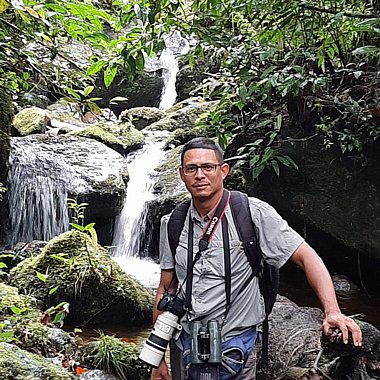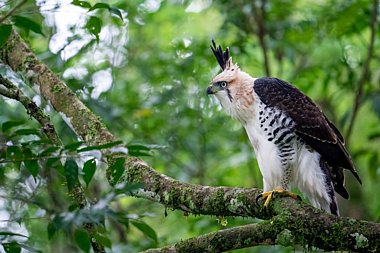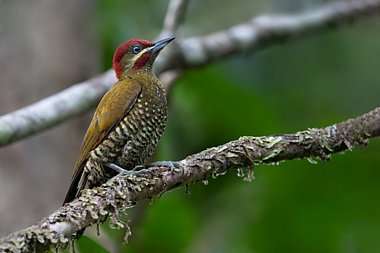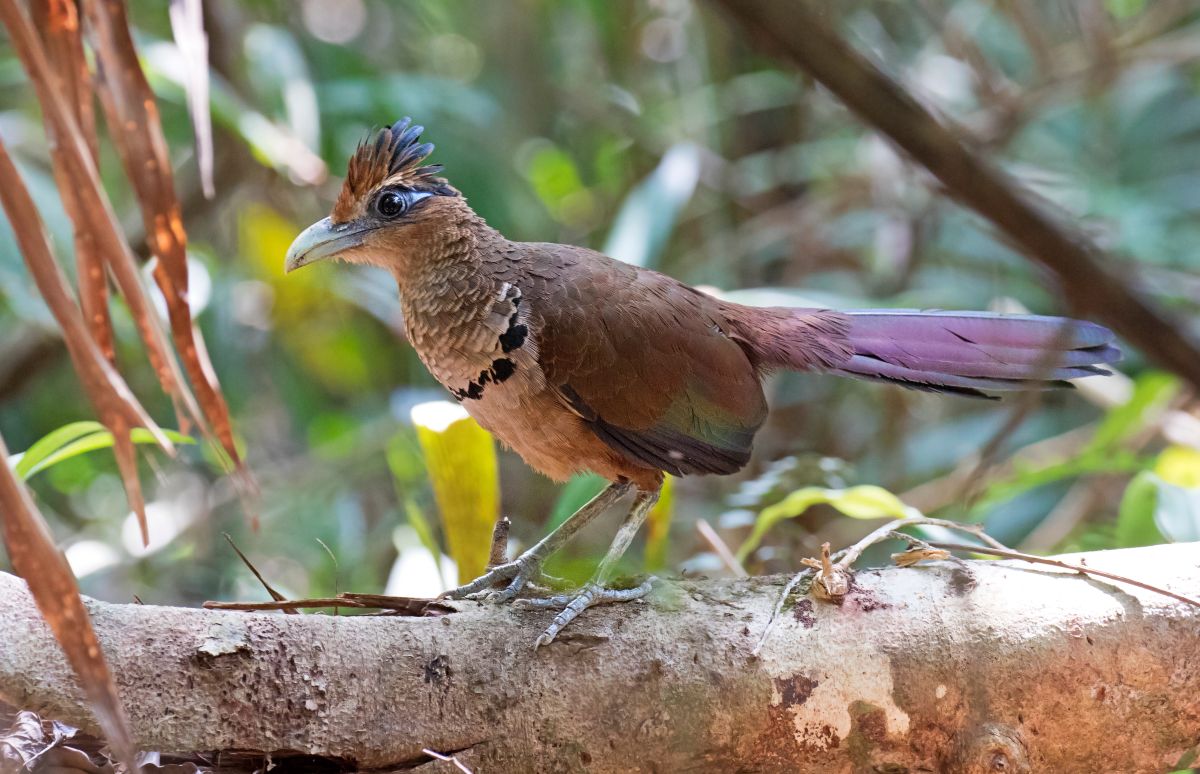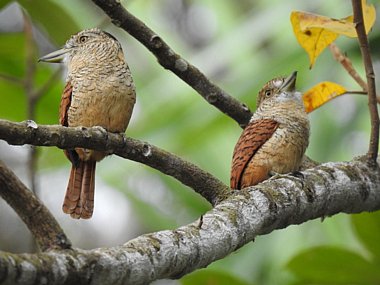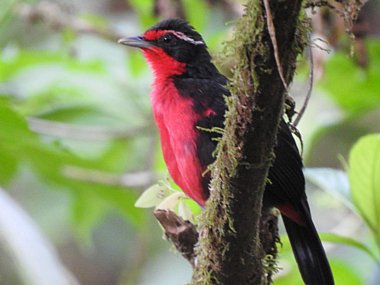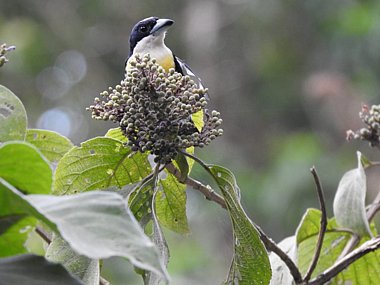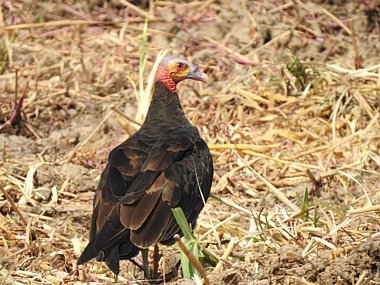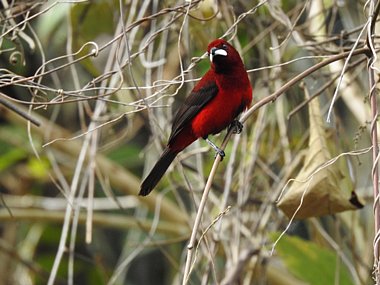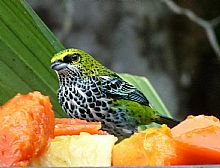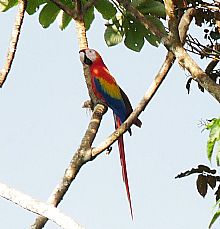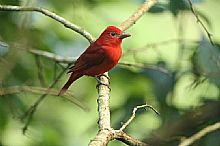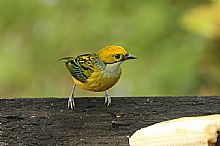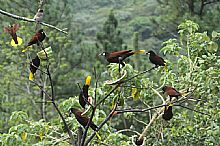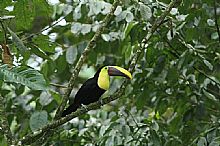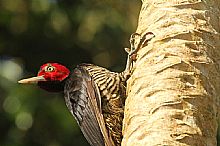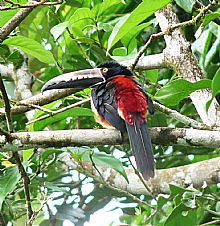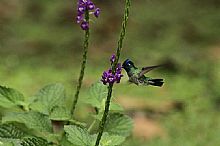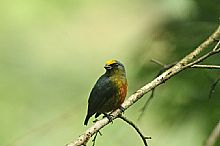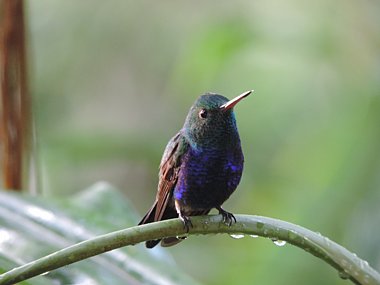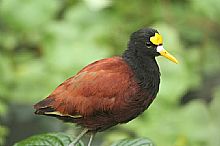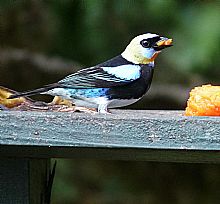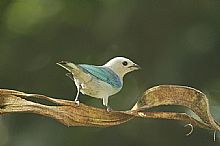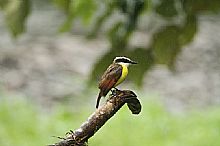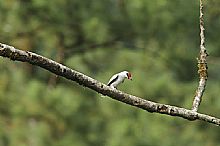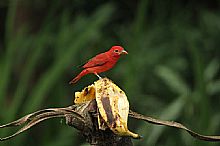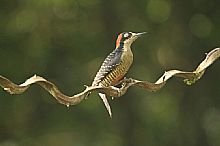NEW! Panama
Re-designed for 2026 - The best of rainforest and cloud forest birding!
| Destinations | |
|---|---|
| Focus | |
| 2026 Dates | |
| Duration | 16 Days |
| Guides | |
| 2026 Price | £6295 pp £595 single supplement. Deposit £1200. Join Heatherlea favourite Paco Madrigal and Panama expert Euclides. pre-flight airport hotel and lounge are inc. |
With its stunning Caribbean and Pacific coasts and broad variety of habitats, Panama is a popular birding destination for good reason. At the cross-roads between Central and South America, it holds almost 1,000 species, nearly 10% of world’s bird species, over 100 are endemic or near-endemic, and over a hundred are South American species that are found no further north.
Re-designed for 2026 - this new-look holiday is based in two locations. The first nine nights are focussed around central Panama, and we stay at Summit Hill Rainforest Resort, a good quality hotel well used to birding tours. We visit key hotspots including the famous Discovery Centre’s Canopy Observation Tower (the views of the vast forest from the Tower are spectacular, as is the outstanding birding!), Pipeline Road, Plantation Road, Summit Ponds, Old Gamboa Road, Semaphore Hill, Ammo Dump and Metropolitan Park, all a short distance from Panama City. We visit the misty cloud forests of El Valle de Anton to find some great specialities. One of the highlights of the holiday will be one afternoon visiting the world-famous Panama Canal, where we will enjoy a walk through the Panama Canal Museum. Afterwards, we will be amazed by the Miraflores locks where we will have the chance to witness large cruise and cargo ships pass through. We also visit the Cerro Jefe/Cerro Azul region and then head up into the cooler Anton Valley for four nights, staying in a lovely, quiet lodge amongst the picturesque forests of the uplands before transferring to an airport hotel for the final night.
Due to its privileged topography and geographical layout, Panama offers fabulous, easily accessible birding, and we won’t have to travel far to see an enormous diversity. Most of the best areas are within one hour of Panama City, making for wonderfully comfortable birding days, and our holiday will be relaxed and non-intensive. Most days may involve two-three miles on foot, but always undertaken at ‘birders’ pace’!
Those of you who have travelled with Heatherlea to Costa Rica will already know the rich variety of birds available in Central America. In Panama you will be able to add many species we don’t usually see in Costa Rica, just a few of which include Blue Cotinga, Violet-bellied Hummingbird, Sapphire-throated Hummingbird, White-vented Plumeleteer, Black Throated Mango, Snowy-bellied Hummingbird, Long-billed Starthroat, Rufous-crested Coquette, Red-capped, Blue-crowned, Lance-tailed and Golden-collared Manakin, Rufous-vented Ground Cuckoo, Pheasant Cuckoo, Marbled Wood-Quail, Ocellated, Spotted, Jet, and Bare-crowned Antbird, wrens, antwrens, woodcreepers, woodpeckers, Rosy Thrush-Tanager, Tawny-crested, Dusky-faced, Yellow-rumped, Flame-rumped and Crimson-backed Tanagers, Capped Heron, Black-chested Jay, Orange-bellied Trogon, Rusty Margined Flycatcher, Barred Forest Falcon, Blue-throated Toucanet, Tarcarcuna Chlorospingus, and Lesser Yellow-headed Vulture. There are many, many more! There are also lots of mammals here, including Capybara, two sloth species, Coatimundi, and several monkey species.
We have organised this trip to take place in November to connect with a flurry of resident Panamanian birds preparing for the breeding season and are also likely to see a great number of raptors, shorebirds, North American warblers, and other migrants. November is the end of the green season, so the landscape should be verdant, with lots of fruiting and flowering trees and plants.
OUTLINE ITINERARY
Enjoy your complimentary pre-flight overnight hotel before your holiday begins. Full details from our office! Read more about our Pre-flight Service here!
Day 1: Arrive to Panama City
After relaxing in our complimentary VIP Airport Lounge, we fly from London, via a European hub, to Tocumen International Airport, where we will be warmly welcomed and escorted to the Summit Rainforest Resort, where we will stay in a comfortable, international style hotel, centrally located for our birding adventures, for the next nine nights.
Days 2: Pipeline Road, Panama Rainforest Discovery Center and Observation Tower
We spend a full day exploring Pipeline Road and the surrounding areas. This is a hotspot of Panamanian birding where we can see an impressive variety of forest birds over a 17 km stretch of road. Pipeline Road runs through the famous Soberania National Park where we have the opportunity to explore deeper into the forest on several side-trails. Some of the highlights of this area include Olivaceous Flatbill, Black-tailed Trogon, White-tailed Trogon, Crimson Crested Woodpecker, Western Slaty Antshrike, Checker-throated Antwren, Bicolored Antbird, Red capped Manakin, Blue crowned Manakin and of course we also hope to find rarities including as Rufous-vented Ground Cuckoo, Pheasant Cuckoo and Great Jacamar to mention a few. There’s no shortage of raptors here! We will be looking for all three species of Forest Falcon, Great Black Hawk, White and Barred Hawk.
We visit the Panama Rainforest Discovery Centre from Pipeline Road. We will enjoy the unique above-canopy vantage point by climbing the 32 m tall Observation Tower. Views of the vast forest from the tower are simply spectacular; from this vantage point you can see ships on the Panama Canal, the majestic Centennial Bridge, and miles of rainforest! From here, you get a unique eye-level perspective of the rainforest canopy. Many birds, including toucans, parrots, various tanagers, hawks and more are seen. The hummingbird feeders at the base of the Tower are good for Long-billed Hermit, White-Necked Jacobin, Violet-bellied & Blue-chested Hummingbirds and White-vented Plumeleteer. Occasionally, a Snowy-bellied Hummingbird is spotted! We will be looking out for Black Breasted Puffbird, Pied Puffbird, Great Black Hawk and the special of the day, Blue Cotinga
Day 3: Metropolitan Nature Park
Today, right after breakfast, we visit Metropolitan Park. Despite its location right inside the city, this incredible city park offers an amazing variety of birds and other animals. The forests here are considerably drier than the habitats we have seen thus far, providing a new array of species. A few common species in the area are Lance-tailed Manakin, White-bellied Antbird, Western Slaty Antshrike, Forest Elaenia, Southern Bentbill, Rosy Thrush-Tanager, Short-tailed Swift, Yellow-crowned Amazon, Common Potoo and Yellow-rumped Cacique. We also look for Rufous-brested and Rufous-and-white Wren, Cocoa and Olivaceous Woodcreeper, White-necked Puffbird, Crimson-backed Tanager, Golden-fronted Greenlet, Lineated Woodpecker, Southern Beardless Tyrannulet, and the harder to find endemic Yellow-green Tyrannulet. This is also a great place to see mammals, including Coatimundi, Three-toed Sloth, Three-toed Sloth, and Geoffrey’s Tamarin.
Day 4: Cerro Azul & Cerro Jefe
Today we travel about an hour up to the cool foothills of Cerro Azul (2,500 ft in elevation) and Cerro Jefe (3,300 ft in elevation) where we will be dazzled by an array of magnificent birds including Emerald, Speckled, Rufous-winged, Golden-hooded, Silver-throated, Bay headed, Hepatic, Olive and Black-and-yellow Tanagers. This is part of the most important protected area vital to the health of the Panama Canal watershed, preserved within the Chagres National Park. A few other target species include majestic Ornate Hawk-Eagle, Spot-crowned Barbet, Scale-crested Pygmy-Tyrant, and endemic Stripe-cheeked Woodpecker and if we are really lucky, the near-endemic Tacarcuna Chlorospingus.
Day 5: Pipeline Road
As it is such an important area, with so much wildlife on offer, we spend another local day birding the Pipeline Road hoping to catch up with the wealth of antbirds, toucans, ground-cuckoos, flycatchers, hummingbirds, tanagers and raptors on show – every day is different along the pipeline!
Day 6: Semaphore Hill and Ammo Dump
Semaphore Hill is a jungle-lined road winding down another nearby section of the Soberania National Park. In this habitat we look for more forest birds including Slaty Antwren, White-flanked Anwren, Fasciated Antshrike, Marbled Wood-Quail, Great Tinamou, Rufous Motmot and many others. This is a great place to look for antbirds as army ant swarms are a common occurrence, and gorgeous Ocellated Antbird, Spotted Antbird and Bicolored Antbird follow the ants. There are lots of mammals here and in the surrounding Central Panama region, including Brown-throated Three-toed Sloth, Hoffman's Two-toed Sloth, Coatimundi, Mantled Howler Monkey, White-faced Capuchin, Geoffroy's Tamarin, Capybara, Kinkajou, and Northern Tamandua.
Later in the day we visit the pond at Ammo Dump, a fantastic spot to see water birds. A few of our targets will be Least Grebe, Purple Gallinule, Common Moorhen, Striated Heron, and hard-to-find Capped Heron. This is also the best place to find the White-throated Crake. Least Bittern, Rufescent Tiger-Heron and American Pygmy Kingfisher are also resident. Here we should also find Olivaceous Piculet, Yellow-tailed Oriole, Southern Lapwing, Yellow-crowned Tyrannulet, Scrub Greenlet and Panama, Social & Rusty-margined Flycatchers, among others, in the surrounding trees & marshy fields. Hook-billed & Snail Kites, Collared Forest-Falcon, Yellow-headed Caracara, Zone-tailed & Short-tailed Hawks are here sometimes too!
Day 7: Plantation Road, Summit Ponds and Old Gamboa Road.
Today we explore another incredible section of the Canal Corridor region. A mix of secondary forest, open areas, gardens, and patches of dry forest, scrub, grasslands, river banks and natural ponds provide for a great day of birding. Plantation Road runs through an old growth forest and areas of secondary forest on the north side of the Continental divide. Much of the forest here is tall and has very little forest undergrowth, making spotting forest floor species like tinamous and leaftossers unusually easy. Here we hope to see Southern Bentbill, Golden-crowned Spadebill, Slaty-tailed Trogon, Blue-crowned Motmot, Buff-rumped warbler, White-breasted Wood-wrens, a variety of antbirds, Gray-headed Tanagers, and woodpeckers (including Plain-Brown and Northern-barred) among many others.
Next we head to Summit Ponds and finally Old Gamboa Road. As well as nesting Boat-billed Herons, we will be keeping a look out for Striated Heron, Green Heron and possibly Capped Herons, as well as Wattled Jacana. This is also a great place to see Kingfishers…all six species belonging to the Americas have been seen here. We will finish off our rewarding day along a true hot spot, Old Gamboa Road. The diversity of habitats featured here yield an incredible variety of birdlife including Jet Antbird, Great Antshrike, Rosy Thrush-Tanager, Lance-tailed & Golden-collared Manakins, Black-tailed & Royal Flycatchers, Lesser and Great Kiskadee, Buff breasted Wren and Rusty Margined Flycatcher. We will return to our hotel for a wonderful meal, go over the daily check-list and enjoy a well-deserved rest with the promise of another great birding day to follow.
Day 8: Campo Chagres
A day birding in the biodiversity hotspot of the Chagres National Park, where dry forest runs down to the eastern side of the Panama Canal and the forest edge and wetland birds. Another wide selection of must-see Central American species is found in this area, amongst which we may see Lance-tailed Manakin, Yellow-green Tyrannulet, Rufous and White Wren, Jet Antbird, Rosy thrush Tanager, White bellied Antbird and the rare Pheasant Cuckoo. The water holds Amazon, Green & American Pygmy Kingfishers, herons, egrets and other waterbirds.
As with all Panamanian forests, the potential for birds is incredible, with Whooping Motmot, Cinnamon Woodpecker, Black-tailed Trogon, Streak-chested Antpitta, Black-faced Antthrush, Red-capped Manakin, Northern Schiffornis, Cinnamon Becard, Golden-collared Manakin, Buff-breasted Wren and Gray-headed Tanager all possible in the trees, and raptors always possible overhead!
Day 9: Round up day
A day spent targeting species that remain unseen before we move locations for the final part of the trip. There is potential that we may visit the Chagres River, Gotun Lake or the Panama Canal itself and visit the not-for-profit Canal Museum. These waters hold Snail Kite in good numbers, Cocoi and Tiger Herons, Wattled Jacana, Greater Ani, Lesser Kiskadee and Panama Flycatcher amongst the more common waterbirds but being in close proximity of enormous cargo ships as they cruise by is another highlight!
Day 10: Valle de Anton
We journey two hours from Panama City up into cloud forest country. We will enjoy cooler temperatures and stunning misty mountain vistas. This new region and habitat will bring a flurry of new birds, including a slew of unabashedly colourful birds.... Flame-rumped Tanager, Crimson-backed Tanager, Blue-grey Tanager, Red-crowned Ant-tanager, White-lined Tanager, as well as the more modest Dusky-faced & Plain-coloured Tanagers. A few other highlights of this area are White-tipped Sicklebill, Black-chested Jay, Snowy-bellied Hummingbird, Rufous-capped Warbler, Thick-billed Euphonia, Chestnut-headed Oropendola and if we are lucky Rufous-crested Coquette. We arrive in the afternoon, birding along the way. After settling into our new lodgings, we will have time to explore the surrounding areas of this quaint mountain village where the easy-access birding right along the road will delight you. We stay here for four nights, and you should sleep well in this cool climate.
Day 11: Valley Anton Area Birding, Macho Falls
We spend the day exploring the exuberant forests of the Macho Falls area. This is an incredible birding spot. We hope to be dazzled by Black-chested Jay, Red-crowned Ant-Tanager, White-throated Robin and if we are lucky Rufous-vented Ground Cuckoo. We will also be looking for Tody Motmot, White-tipped Sicklebill, Pale-eyed Pygmy-tyrant, and Sepia-capped Flycatcher. Besides the incredible birding, the forests (and the waterfall!) are simply breath-taking!
Day 12: Cerro Gaital & Mesa Road
In the morning we will venture further up the mountain to Cerro Gaital where we will look out for Shiny Cowbird, Southern Lapwing, Streaked Saltator, and even further up Blue-throated Toucanet, Black Guan, and Orange-bellied Trogon. And let’s not forget the raptors! Black Hawk-Eagle, Barred Hawk, Gray Hawk, Swallow-tailed Kite, Barred Forest Falcon, Bat Falcon, and maybe even Black and White Hawk Eagle, all of which inhabit the area.
We spend a good portion of the day along Mesa Road which offers a wonderful mix of habitats, including pasture, secondary forests, and semi-open areas. Some of the highlights we will be looking for today include rare Blue Seedeater, Bran-coloured Flycatcher, Tawny-faced Antwren, Tawny-crested Tanager, White-thighed Swallow, Spot-crowned Antvireo, Rufous-crested Coquette, Spotted Woodcreeper and Orange-bellied Trogon among many others. We return to the lodge for dinner and to go over the checklist for the day.
Day 13: Anton Valley Area Birding
We will spend the day venturing out for a day trip in the area. Depending on weather conditions, today could include a visit to the highlands of Altos de Maria, or a few of the many great birding trails close to our lodge, traversing Caribbean slope and Tropical dry forest coastal habitats for shorebirds. It promises to be an amazing day of birding where we will pick up plenty of new species. A few of our targets may include White-bellied Antbird, Yellow-backed Oriole, Panama Flycatcher, Long-billed Starthroat, Jet Antbird, Rufous-breasted Wren and Great Antshrike, among many others.
Day 14: Tropical Dry Forests of Cocles Province
After a final breakfast in our lodge, we return to the Gamboa region just outside Panama City. En route we will spend most of the day in the unique Tropical dry forest of the Pacific Coast lowlands. Here we plan to add a new medley of birds to our sightings, including the rare endemic Veraguan Mango. Other spectacular inhabitants of the area are Lesser Yellow-headed Vulture, Savannah Hawk, Sapphire-throated Hummingbird, Blue Ground-Dove, and even Mouse-coloured Tyrannulet and Lance-tailed Manakin. We sure to have memorable final day in Panama before arriving at our hotel near Panama City.
Day 15: Transfer to Tocumen International Airport
Today we can enjoy a leisurely breakfast before packing for our journey home. We may enjoy a last birding walk close to the hotel, followed by lunch. Transfer to the airport for our overnight flight back to the UK, via a European hub.
Day 16: Arrival into the UK
Please note: all itineraries are given as a guide only. Actual holiday content may vary according to the judgement of your guide, and elements beyond our control (eg weather).
What's included in your holiday price:
- Scheduled return flights between London and Panama City, airport taxes, ground transportation as outlined including all transportation in Panama, accommodation and all meals, including breakfast, lunch and dinner. Water is provided in the vehicle each day.
- The services of your leaders.
- Entrance fees to parks and reserves, and tips to hotels and restaurants.
- Departure taxes.
- Pre-flight airport hotel and lounge included subject to terms and conditions.
- Free Field Guide! - 'The Birds of Panama' by is included in your holiday price. One copy per room booked.
What's not included in your holiday price:
- Personal insurance
- personal expenses including drinks ordered at the lodges
- visa costs where necessary
- Tips to the driver and local guide
- any other costs not specified as 'included'.
More holiday information:
Accommodation is in hotels or lodges with all rooms en suite. Some of the lodges are remote, and have simple-style rooms. All are spacious, have en-suite facilities, and are very comfortable to a good standard.
Food is usually served as a buffet, with a wide choice. Vegetarian and other diets are welcome.
Walking is generally light - moderate. There may be some uphill track and road walking, though generally an average level of fitness is required.
Weather will be mixed. Mostly the temperature will be warm, with the possibility of rain. In some locations the weather is hot and humid, in others hot and dry, and at altitude can be cool and wet.
Insects There are biting insects, though not usually as a major problem.
Group size is restricted to 12 clients maximum.
Flights are from London. We may be able to offer flight arrangements from another airport and/or or quote without flights so you can make your own arrangements. If you wish to add an extension either before or after your holiday, please contact us and we will be happy to arrange this for you.
Your Leaders:
Paco Madrigal
Paco is an exceptional Leader, and we are fortunate to secure his services. Paco was raised in the lowland rain forest of Sarapiqui, Costa Rica, and has over 30 years experience guiding both bird watching and natural history tours throughout Costa Rica and Panama. As a child, the rain forest was his backyard playground. He learned about the diverse local plants and animals from his father who had learned from his father. Paco became the first resident naturalist guide at the Selva Verde Lodge tropical reserve, and in 1989 was selected to participate in the first 4 month intensive training course for naturalist guides, sponsored by the World Wildlife Fund and the Organization for Tropical Studies.
Paco studied English and Ornithology at the University of Florida. Upon returning to Costa Rica, Paco worked for the renowned Organization for Tropical Studies (OTS) at La Selva Biological Station in Sarapiqui where he began to lead guided tours, and his personal enthusiasm to share his knowledge with visitors has led to a devoted following. We can tell you from extensive first-hand experience that Paco is extremely capable with wildlife, organisation and people.

Paco Madrigal
Euclides "Kilo" Campos
During the first week, we will also be enjoying the services of 'Kilo', a local Panamanian Guide. With "Kilo" it naturally feels like birding with a friend. He holds a Nature tourism degree from the National University of Panama, and has participated in numerous national and international bird projects such as Hawk Mountain Sanctuary in Pennsylvania (2005).
He speaks English fluently and loves showing the birds to visitors. Patient and attentive, he always receives high praise at the end of the trip. good at birdsong, 'Kilo' holds the record of seeing 778 Panama Birds in 2019.
Other birding and wildlife holidays in Central America & Caribbean
- Costa Rica Classic Tour
- Costa Rica Classic Tour - PLUS!
- Costa Rica with Easy Walking
- NEW! Belize - Wildlife of the Yucatan Peninsula
- NEW! Costa Rica: Birding, Whales and wildlife during migration
- NEW! Cuba including Havana
- NEW! Jamaica, Dominican Republic and Puerto Rico
- NEW! Lesser Antilles - A Caribbean Island Hopping Adventure
- NEW! Mexico - Oaxaca
- NEW! Tranquil Trinidad
- Trinidad, Tobago and Saint Lucia
Why choose Heatherlea for your birding and wildlife holiday in the Americas?
Our overseas holidays are planned with care to offer great birding and wildlife, led by capable Leaders who really look after you. Every holiday is run the 'Heatherlea Way', and we hope our Overseas Adventures remind you of the quality and care so many of you enjoy in Scotland. That means rewarding and exciting days in the field, and good quality accommodation and meals, with a real flavour of the country we are visiting. Heatherlea always seek to include the personal touches that make all the difference.
Heatherlea holidays are not ‘dawn to dusk’ expeditions. Our less-intensive approach is ideal for those who want to relax whilst experiencing the best wildlife watching, and wherever possible we organise early or late activity on an optional basis. We also take sensible breaks when in very hot places and regular comfort breaks on every holiday whenever possible. All itineraries are planned carefully around the best wildlife opportunities, and you won’t miss out on memorable wildlife, whilst enjoying relaxed, informal days that are great fun.
The really important part of any wildlife holiday is the experience for you, our valued customer. Heatherlea invest in many things to offer you the best possible service;
- We have been organising birding and wildlife holidays for over 30 seasons, and have a highly experienced and capable office team. We also offer a telephone and email service outside normal office hours.
- Heatherlea overseas holidays have a maximum of 12 clients per trip, putting the emphasis on personal service, and helping you get the best possible experience.
- Our holidays often include things which others might invite you to pay yourself, for instance Departure Taxes and tips to hotels.
- All elements of our holidays are sold under our own licence, ATOL 6113. Under ‘Flight-Plus’ legislation it is a legal requirement of any tour operator to hold an ATOL licence for the supply of any overseas holiday where a flight is involved, if that holiday includes either overseas accommodation and/or car hire. It can be a criminal offence for an operator to book flights as part of a package without an ATOL licence. Heatherlea also hold full Tour Operator Insurance for your added protection.
- Heatherlea is your complete wildlife holiday provider. Our ‘Back Office’ team can organise all your pre-flight and other travel needs. Our specialists will help you book the right services, at the best price. Book holiday extensions through us, and your ATOL protection is extended further. We don’t charge extra for this service.
- Heatherlea is a limited company, registered in Scotland, and registered to pay VAT (applies to all holidays within the European Union).

